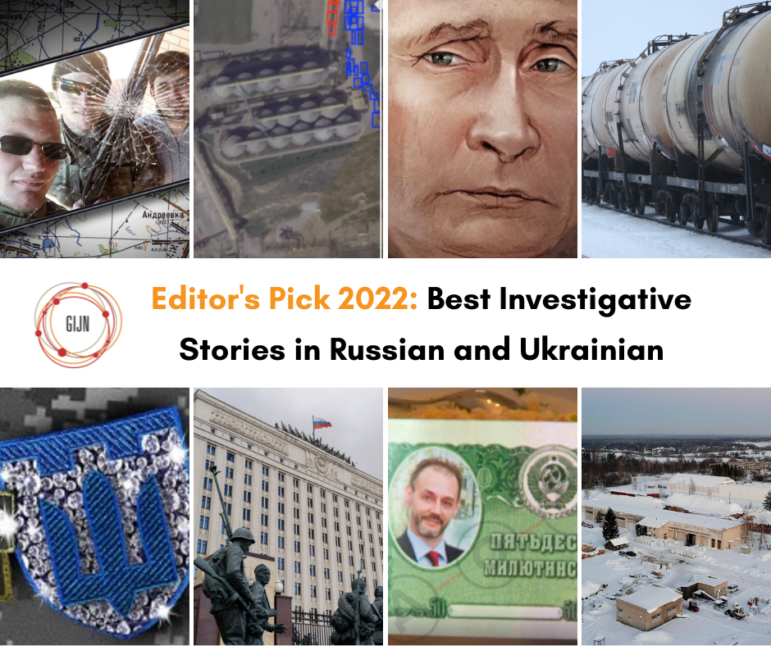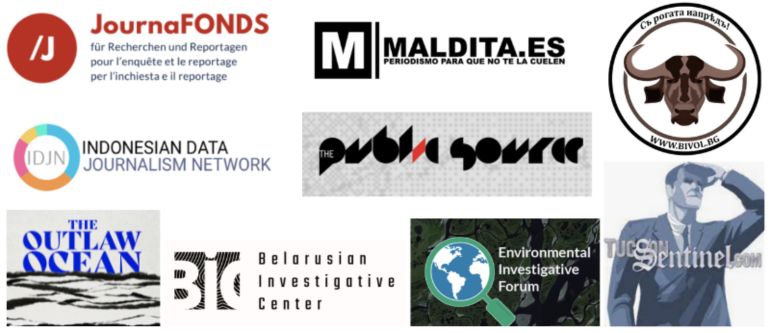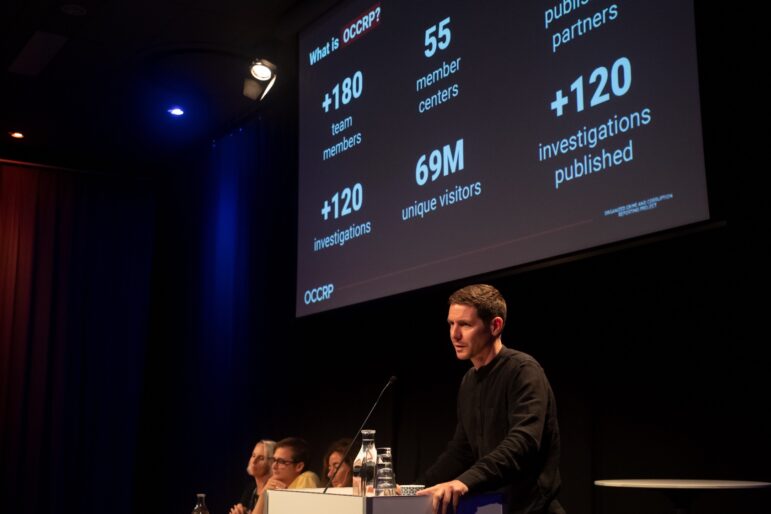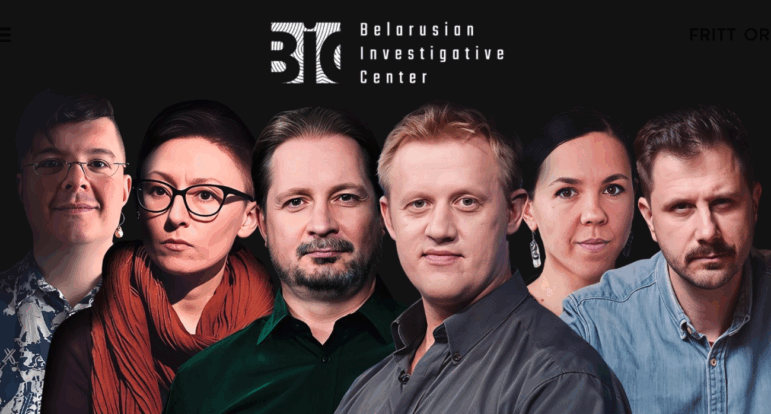

The Belarusian Investigative Center was among the 2025 Free Media Award winners. Image: Screenshot, Fritt Ord Foundation
Uncovering Schemes Worth Billions: Inside the Belarusian Investigative Center
Read this article in
For decades, Belarus was considered a “blank spot” on the international map of investigative journalism. Its government consistently ranks as the least open in Europe. Despite this, investigative journalism is in its best state ever, with the [GIJN member] Belarusian Investigative Center (BIC) at the forefront. Since its formation, the outlet has systematically exposed high-level corruption and disinformation, leading to dozens of international sanctions and earning global recognition.
The Fix spoke with BIC founder Stanislav Ivashkevich about investigating the Belarusian regime.
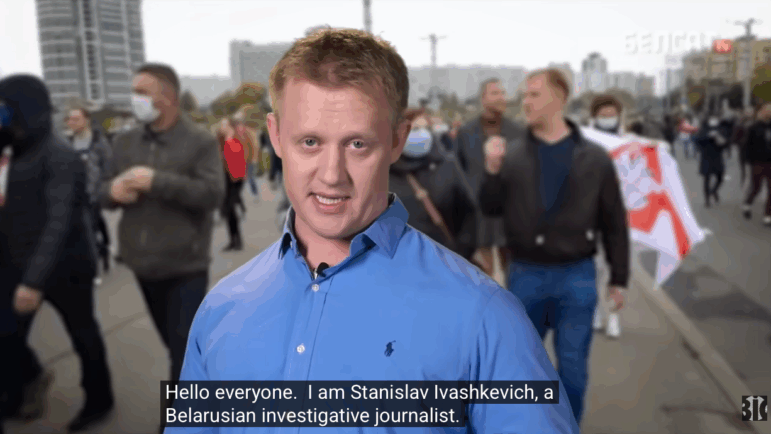
BIC founder Stanislav Ivashkevich. Image: Screenshot, Belarusian Investigative Center YouTube channel
‘Henry Ford-ization’ of Investigations
The previous state of Belarusian investigative journalism largely consisted of “investigative features” with only national significance. “When I attended the Organized Crime and Corruption Reporting Project’s (OCCRP) summer investigative school in 2016, I learned that on the international map of investigative journalism, Belarus is considered a ‘blank spot.’ And a hopelessly blank one, the only one in all of Europe,” recalls Ivashkevich.
That summer school planted the seed for what would become BIC. The team first began forming in 2017 as part of the TV program Let’s Figure It Out on the Belsat TV channel. In 2018, it spun off into a commercial production company before eventually evolving into the nonprofit media outlet it is today.
To produce more investigations of higher quality, the outlet adopted a unique, process-driven approach. “We managed to achieve this through what I call the ‘Henry Ford-ization’ of investigations. We built pipelines where outstanding journalists could multiply their skills and capabilities by focusing on the specific processes they excel at,” Ivashkevich explains. This structure drew partly on processes learnt from international partners like the OCCRP.
How the Investigative Machine Works
Today, BIC’s team comprises more than 30 people, with a majority based in Warsaw, across departments for analytics, counter-disinformation, and journalistic investigations. The complexity of their work is immense: at any given moment, up to 40 different story hypotheses may be in development within the investigations department. Some will eventually lead nowhere or be shelved for future consideration.
As a result, the team publishes around 20 major investigations per year. Each receives around 500,000 views across both BIC’s channels, together with reprints from other media outlets.
To maintain focus, the outlet prioritizes schemes related to corruption or sanctions evasion worth more than US$20 million. This high-stakes work carries significant risks. “After every investigation, we could face a lawsuit. We receive legal threats or pre-litigation warnings for roughly every third or fourth investigation,” Ivashkevich notes.

Image: Reporters Shield
To protect itself, BIC has a dedicated team of fact-checkers and is insured against strategic lawsuits (SLAPPs) through the Reporters Shield initiative, an OCCRP project. “When the biggest oligarchs send their expensive lawyers after us, our lawyers are definitely not inferior in class, and sometimes it seems they are even superior,” Ivashkevich adds.
Sanctions, War Crimes, and Anti-Disinformation
The results of the BIC’s work are tangible. Since 2020, their investigations have led to approximately 90 sanction actions against more than 40 individuals and legal entities by the European Union and the United States.
In 2023, journalists discovered that Belarusian oligarch Aleksandr Shakutin had evaded earlier EU sanctions while maintaining a profitable German business. Meanwhile, he ran the loss-making Amkodor holding at Belarusian taxpayers’ expense of about US$100 million. This investigation led to sanctions on Amkodor and Shakutin’s partners who helped him circumvent restrictions.
Another Lukashenka ally, Victor Chevtsov, was sanctioned in August 2024, three months after BIC’s investigation. Journalists exposed his monopoly on security hologram production in Belarus, as well as his Hungarian company, through which Chevtsov earned money in Europe.
By the outlet’s count, the total value of schemes uncovered in collaboration with partners reaches nearly US$2 billion this year alone.
BIC’s founder notes that some investigations aren’t focused on sanctions: “War crimes don’t have a monetary value, so we investigate all those we consider significant.” As an example, this September, the team released an investigation into Belarusians fighting on the Russian side in its war against Ukraine.
Moreover, BIC runs the anti-disinformation project called Weekly Top Fake. It grew from the outlet’s own fact-checking process. “If you dig into the reason why the regime is lying about something, you might find a lead for an investigation,” Ivashkevich explains.
Today, Top Fake is a weekly YouTube program with a dedicated TikTok account with 90,000 subscribers. Each episode receives an average of 470,000 views on these platforms combined. The department is a member of the International Fact-Checking Network (IFCN) and the European Fact-Checking Standards Network (EFCSN).
A recent edition of BIC’s Weekly Top Fake show on YouTube.
‘Belarusian Investigative Journalism Is Now in Its Best State Ever’
BIC’s success reflects a broader trend. Ivashkevich asserts that “Belarusian investigative journalism is now in its strongest state ever.” He likens its development to a character from Slavic folk tales “who lay on the stove for 30 years, but once he got up… it’s still just picking up speed.”
Several factors fuel this boom. The hacktivist group Cyber Partisans made a major contribution by opening up many previously inaccessible government databases. This, combined with other leaks since 2020 and the absence of official anti-corruption work by state agencies, has created fertile ground for journalists.
Ivashkevich mentions other outlets, like Bureau Media, Belpol, and Mediazona, that have also produced high-level investigations, signaling a broader rise of the field.
Surviving on Grants: Unfortunate Case of Belarusian Exile Media
BIC operates almost entirely on funding from international donors. Independence is ensured through extensive diversification, with dozens of different donors supporting the outlet at any given time. Several of them are listed on a dedicated page of BIC’s website.
Other revenue streams are nearly impossible. Donating from within Belarus is highly dangerous, as BIC is designated an “extremist organization,” and a person could face years in prison for providing financial assistance. Funds from the Belarusian diaspora are also limited, as they are often directed toward other urgent needs like supporting political prisoners or Ukraine.
This makes international partnerships essential. Ivashkevich highlights OCCRP’s role in providing a global network of investigators with access to the latest tools and crucial structural knowledge. “The era of individual investigative journalists, I would say, belongs to the 20th century… Today, the highest-profile investigations are done by consortiums and ‘corporations’ whose goal is not profit, but maximum impact on real life,” he concludes.
Editor’s Note: This story was originally published by The Fix and is reprinted here with permission.
 Hleb Liapeika is a freelance journalist based in Krakow, Poland, covering the Belarusian diaspora and European independent media for The Fix. He is a former journalist at Mediazona.Belarus.
Hleb Liapeika is a freelance journalist based in Krakow, Poland, covering the Belarusian diaspora and European independent media for The Fix. He is a former journalist at Mediazona.Belarus.



